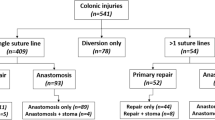Abstract
Purpose
The objective of this study is comparing colon diversion versus primary repair in penetrating colon gunshot injuries.
Methods
A retrospective study of 63 cases of gunshot abdomen with penetrating colon injury were admitted to Al-jalla Hospital in 2011 in Benghazi, Libya. After surgical intervention, these patients were observed for any postoperative complications.
Results
During the study period, 63 eligible patients included, 62 (98.4 %) were males and 1 (1.6 %) was female. And the mean age was 29.24 years. Eighteen patients had an injury on the right side of the colon, while 16, 6, 11, 6, 2, 3, and 1 patients had an injury on the transverse, left, sigmoid, rectum, right transverse, left transverse, and total colonic injury, respectively. In the first group, 23 patients (36.5 %) was treated with colon diversion, (2 with Hartmann’s operation, 21 with loop colostomy). In the second group, 40 patients (63.4 %) was treated with primary repair. Eighteen (28.5 %) with right hemicolectomy, 5 (7.9 %) with transverse colon resection and anastomosis, and 17 (26.9 %) with simple repair. We evaluate the rate of postoperative complication and compare the postoperative morbidity between both groups.
Conclusion
In our study, there was no significant statistical difference between types of operations and rate of complications (P = 0.18). We could not see any advantage of the diversion over the primary repair. To reduce risk of the psychological trauma, complications of colostomy, unnecessary repeated hospitalization, decrease of economic cost, and complications of stoma revision operation, we should consider that the primary repair of penetrating colon injuries is an acceptable alternative method of treatment over the colostomy.


Similar content being viewed by others
References
Bodalal Z, Mansor S (2013) Gunshot injuries in Benghazi, Libya in 2011: the Libyan conflict and beyond. Surgeon 11:258–263
Affair a AMACoS (1989) Firearm injuries and death: a critical public issue. Public Health Rep 104(2):111–120
Wintemute G, Teret S, Kraus J (1987) The epidemiology of firearm death among resident of California. West J Med 7:374–377
Meddings D (1997) Weapons injuries during and after period of conflict: retrospective analysis. BMJ 315:1417–1420
Duncan JE, Corwin CH, Sweeney WB, Dunne JR, Denobile JW, Perdue PW, Galarneau MR, Pearl JP (2008) Management of colorectal injuries during Operation Iraqi Freedom: patterns of stoma usage. J Trauma 64(4):1043–1047
Maxwell RA, Fabian TC (2003) Current management of colon trauma. World J Surg 27:632–639
Stone HH, Fabian TC (1979) Management of perforating coloTrauma: randomization between primary closure and exteriorization. Ann Surg 190:430–436
Demetriades D, Murray JA, Chan L, Ordoñez C, Bowley D, Nagy KK et al (2001) Penetrating colon injuries requiring resection: diversion or primary anastomosis? An AAST prospective multicenter study. J Trauma 50:765–775
Sasaki LS, Mittal V, Allaben RD (1994) Primary repair of colon injuries: a retrospective analysis. Am Surg 60:522–527
Haut ER, Nance ML, Keller MS, Groner JI, Ford HR, Kuhn A, Tuchfarber B, Garcia V, Schwab CW, Stafford PW (2004) Management of penetrating colon and rectal injuries in the pediatric patient. Dis Colon Rectum 47(9):1526–1532
Dokucu A, Ozturk H, Yagmur Y, Otcu S, Onen A, Azal OF, Gurkan F, Yucesan S (2000) Colon injuries in children. J Pediatr Surg 35(12):1799–1804
Eshraqhi N, Mulims RJ, Mayburry JC, Brand DM, Crass RA, Trunky DB (1998) Survey of the performance of American trauma surgeons in management of colon injuries. J Trauma 44:93–97
Durham RM, Pruitt C, Moran J, Lono WE (1997) Civilian colon trauma: factors that predicts success by a primary repair. Dis Colon Rectum 40:685–692
Velmahas GC, Souter I (1996) Primary repair of colonic gunshot wounds. Aust N Z J Surg 32(6):344–347
Steele SR, Wolcott KE, Mullenix PS, Martin MJ, Sebesta JA, Azarow KS, Beekley AC (2007) Colon and rectal injuries during Operation Iraqi Freedom: are there any changing trends in management or outcome? Dis Colon Rectum 50(6):870–877
Jinescu G, Lica I, Beuran M (2013) Traumatic colon injuries—factors that influence surgical management. Chirurgia (Bucur) 108(5):652–658
Ozturk G, Aydinli B, Selcuk Atamanalp S, Celebi F, Ilhan Yildirgan M, Donmez R (2009) Penetrating colon injury: experience of a single centre. Acta Chir Belg 109(2):185–190
O’Neill PA, Kirton OC, Dresner LS, Tortella B, Kestner MM (2004) Analysis of 162 colon injuries in patients with penetrating abdominal trauma: concomitant stomach injury results in a higher rate of infection. J Trauma 56(2):304–312, discussion 312-303
Mahajna A, Krausz MM (2003) Nonoperative management of a penetrating colon injury: case report and review of the literature. J Trauma 54(6):1228–1230
Anjaria DJ, Ullmann TM, Lavery R, Livingston DH (2014) Management of colonic injuries in the setting of damage-control laparotomy: one shot to get it right. J Trauma Acute Care Surg 76(3):594–600
Burlew CC, Moore EE, Cuschieri J, Jurkovich GJ, Codner P, Crowell K, Nirula R, Haan J, Rowell SE, Kato CM, MacNew H, Ochsner MG, Harrison PB, Fusco C, Sauaia A, Kaups KL, W. T. A. S. Group (2011) Sew it up! A Western Trauma Association multi-institutional study of enteric injury management in the postinjury open abdomen. J Trauma 70(2):273–277
Chappuis CW, Frey DJ, Dietzen CD, Panetta TP, Buechter KJ, Cohn I Jr (1991) Management of penetrating colon injuries. A prospective randomized trial. Ann Surg 213:492–497, discussion 497-8
Sasaki LS, Allaben RD, Golwala R, Mittal VK (1995) Primary repair of colon injuries: a prospective randomized study. J Trauma 39:895–901
Gonzalez RP, Falimirski ME, Holevar MR (2000) Further evaluation of colostomy in penetrating colon injury. Am Surg 66:342–347
Conflict of interest
The authors state there is no conflict of interest whatsoever and no funding or support from any party was received in the making of this study.
Author information
Authors and Affiliations
Corresponding author
Rights and permissions
About this article
Cite this article
Mansor, S., Bendardaf, R., Bougrara, M. et al. Colon diversion versus primary colonic repair in gunshot abdomen with penetrating colon injury in Libyan revolution conflict 2011 (a single center experience). Int J Colorectal Dis 29, 1137–1142 (2014). https://doi.org/10.1007/s00384-014-1918-7
Accepted:
Published:
Issue Date:
DOI: https://doi.org/10.1007/s00384-014-1918-7




